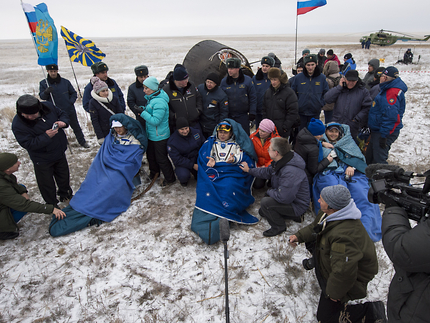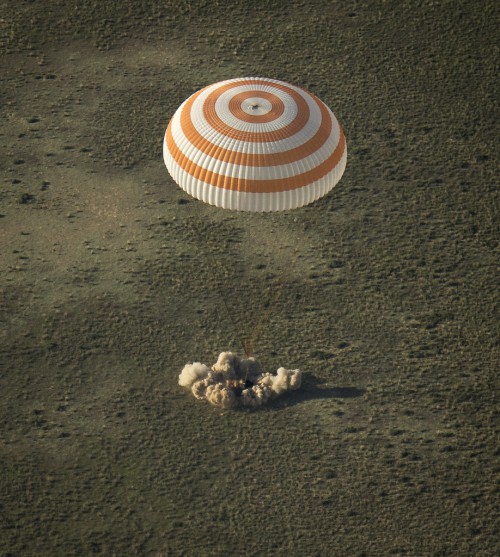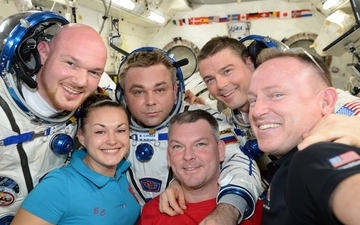
More than 165 days, over 2,500 orbits of the Home Planet, and in excess of 70 million miles (112 million km) traveled since launch, the three-man crew of Soyuz TMA-13M is regaining its “Earth-legs” tonight (Monday, 10 November), in three different nations. Within hours of their triumphant landing in Kazakhstan at 9:58 a.m. local time Monday (10:58 p.m. EST Sunday), Russian cosmonaut Max Surayev returned to the Star City training center, on the forested outskirts of Moscow, whilst NASA’s Reid Wiseman headed back to the Johnson Space Center (JSC) in Houston, Texas, and European Space Agency (ESA) astronaut Alexander Gerst arrived to a rapturous welcome in his homeland, Germany. The International Space Station (ISS) is now well into Expedition 42, under the command of Barry “Butch” Wilmore, which promises to see at least two U.S. EVAs, two SpaceX Dragon cargo missions, the undocking of Europe’s fifth and last Automated Transfer Vehicle (ATV-5), the departure and launch of new Russian Progress resupply vessels, and a huge amount of scientific and technological research.
Following the traditional ISS change-of-command ceremony, in which Surayev relinquished control of the station to Wilmore on Saturday, 8 November, the outgoing crew was able to concentrate fully on preparing their suits, their Soyuz TMA-13M spacecraft, and themselves for a punishing return to terrestrial gravity and a long-awaited reunion with their families and friends. The three men bade farewell to crewmates Wilmore and Russian cosmonauts Aleksandr Samokutyayev and Yelena Serova—who now form the “core” of Expedition 42, which will fly through March 2015—and closed the hatches between the station’s Earth-facing (or “nadir”) Rassvet module and Soyuz TMA-13M at 4:27 p.m. EST Sunday. They undocked from the ISS a little over three hours later, at 7:31 p.m., to begin their 3.5-hour return journey to Earth.
As planned, Soyuz TMA-13M executed a deorbit “burn,” lasting four minutes and 41 seconds, which got underway at 10:09 p.m., slowing the velocity of the spacecraft sufficiently to permit entry into the “sensible” atmosphere. Shortly afterwards, they discarded their spherical orbital module and cylindrical instrument module, leaving only the beehive-shaped descent module to sustain them during the perilous hypersonic descent. “Entry Interface,” at an altitude of approximately 400,000 feet (76 miles, or 122 km), occurred at 10:35 p.m., after which friction with the steadily thickening atmosphere rapidly heated the vehicle’s outer surfaces.
Eight minutes later, Soyuz TMA-13M steaked, meteor-like, through the night sky at a velocity in excess of 515 mph (830 km/h), heading for a touchdown point to the northeast of the large mining city of Arkalyk in north-central Kazakhstan. During this period, the spacecraft underwent rapid deceleration, thanks chiefly to the deployment of four parachutes, beginning about 15 minutes before it hit the ground. Two “pilot” chutes were released, followed by a 258-square-foot (24-square-meter) drogue, which arrested Soyuz TMA-13M’s rate of descent to about 180 mph (290 km/h). Finally, the main canopy—with a fully unfurled surface area of 10,764 square feet (1,000 square meters)—was itself deployed, shifting the spacecraft’s attitude to a 30-degree angle, relative to the ground, dissipating heat, then shifting it back to a straight-vertical descent profile. The main canopy slowed Soyuz TMA-13M to a stately 16.4 mph (26.4 km/h), although this was still too fast for a safe landing. Finally, two seconds before touchdown, solid-fueled rockets in the descent module’s base ignited to cushion the impact.

Max Surayev, Reid Wiseman, and Alexander Gerst hit terra firma at 10:58 p.m. EST Sunday, 9 November (9:58 a.m. local time Monday, 10 November), concluding a mission of 165 days, eight hours, and one minute. The precise location was some 51 miles (82 km) northeast of Arkalyk. During their lengthy and eventful voyage, their circled Earth no fewer than 2,566 times and traveled more than 70 million miles (112 million km). Surayev ended the second mission of his cosmonaut career, having previously flown for 169 days during Expedition 21/22 between September 2009 and March 2010, and has now accrued a total of more than 334 days in space. Wiseman and Gerst both completed their first missions. All three participated in EVAs during the course of their expedition, with Wiseman performing two spacewalks and Surayev and Gerst one apiece.
Recovery forces, including helicopters and all-terrain vehicles, were on the scene within minutes of touchdown and after establishing radio communications with the crew and receiving assurance that all was well, the process got underway to extract humanity’s most recent trio of space explorers from the vehicle. Surayev, in the central commander’s seat, was removed first, followed by a broadly grinning Gerst from the right-side “Flight Engineer-2 position, and lastly a high-spirited Wiseman, from the left-side “Flight Engineer-1” post. Following normal post-landing protocol, the crew was seated in reclining chairs for initial acclimatization, before being moved from the freezing steppe into a nearby medical tent to remove their Sokol (“Falcon”) launch and entry suits and undergo comprehensive checks.
In spite of their good health, returning to the punishing influence of terrestrial gravity after six months of weightlessness was bound to take its toll. “Earth smells amazing,” Gerst tweeted shortly after landing. “It is good to be back on our #BlueDot,” he added, paying tribute to the name of his European Space Agency (ESA) expedition. However, he later admitted that “It is good to be back, even though gravity sucks right now!” Within two hours of touchdown, the three men were flown to the city of Kostanay—the administrative center of Kostanay Province—in the far north of Kazakhstan, for a welcoming ceremony. Surayev was then flown back to Star City, whilst Wiseman and Gerst boarded a NASA Gulfstream III jet, bound eventually for Ellington Field in Houston, Texas. The Gulfstream made its first refueling stop in Glasgow, Scotland, where Wiseman and Gerst parted ways, with Germany’s 11th spacefarer and third spacewalker exchanging aircraft and flying back to the European Astronaut Centre (EAC), near Cologne.
Parting company after six months together aboard Soyuz TMA-13M and the space station, and more than two years of mission-specific training beforehand, was clearly tough. “So long Max! It was an honour to fly to space under your command,” Gerst tweeted earlier today. “Safe travels to Star City, my friend.” After touching down in Glasgow, Wiseman tweeted a photograph of himself and Gerst on the runway, ready to head home to the United States and Germany respectively. “Saying goodbye to an amazing friend and crewmate,” Wiseman wrote. “@astro_alex heads to #Germany. I’m westbound to the #USA.” Responding with similar brotherly sentiment, Gerst tweeted: “So long @astro_reid you are a fantastic friend & best crewmate I could ever wish for. Come visit me in #Germany soon!”
Meanwhile, the current “core” of Expedition 42 and the three-strong team who will soon join them spent Monday enjoying only light duties. Commander Barry “Butch” Wilmore and his crewmates Aleksandr Samokutyayev and Yelena Serova—the latter of whom represents only the fourth Russian woman cosmonaut in history—arrived at the ISS aboard Soyuz TMA-14M on 25 September and will remain until 12 March 2015, by which point they will have accrued 168 days in orbit. They are due to be joined on 23/24 November by the Soyuz TMA-15M crew, which comprises Russian cosmonaut Anton Shkaplerov, NASA’s Terry Virts, and Italy’s first female astronaut, Samantha Cristoforetti. The new crew spent Monday resting in Star City, prior to their scheduled departure for the launch site at the Baikonur Cosmodrome in Kazakhstan.

Expedition 42 promises to be a busy increment aboard the multi-national orbital outpost. At present, two unpiloted visiting vehicles are in residence: Russia’s Progress M-25M cargo ship, launched in late October, which will remain in place until April, and Europe’s fifth and final Automated Transfer Vehicle (ATV-5), launched in July, which will is due to end its mission on 10 February. More than 5,050 pounds (2,290 kg) of supplies for Expedition 42 were lost on 28 October, in the catastrophic explosion of Orbital Sciences’ Antares booster, which saw the destruction of the ORB-3 Cygnus cargo ship. As Orbital begins the process of identifying the cause of the accident—with suspicion currently focusing upon a failed turbopump on one of Antares’ AJ-26 first stage engines—it remains unclear if the planned April 2015 launch date of the next Cygnus mission, ORB-4, is still tenable. Certainly, Orbital does not anticipate returning Antares to service, with upgraded engines, before 2016, which would require the Dulles, Va.-based company to loft ORB-4 atop a different booster.
In the meantime, SpaceX has Eastern Range approval to fly its fifth dedicated Dragon mission (SpX-5), atop the workhorse Falcon 9 v1.1 rocket, from Space Launch Complex (SLC)-40 at Cape Canaveral Air Force Station, Fla., no earlier than 9/10 December. Under the language of a $1.6 billion Commercial Resupply Services (CRS) contract, signed with NASA in December 2008, the Hawthorne, Calif.-based SpaceX is required to stage 12 dedicated Dragon flights by 2016, hauling upwards of 44,000 pounds (20,000 kg) of cargo and supplies to the ISS. As with previous Dragon missions, SpX-5 will follow a three-day rendezvous profile to reach the space station, after which it will be grappled by the 57.7-foot-long (17.6-meter) Canadarm2 robotic arm and berthed on the nadir port of the Harmony node. The Dragon will remain in place for about a month, with current plans anticipating an unberthing and return to Earth on 8 January 2015. This will be followed by the launch of the SpX-6 Dragon, as soon as 4 February, with grappling and berthing planned for the 6th and return to Earth about five weeks later, on 9 March.
After spending the Thanksgiving period, the Christmas holidays and the New Year in space, the six-strong Expedition 42 crew of Wilmore, Samokutyayev, Serova, Shkaplerov, Virts, and Cristoforetti will inaugurate 2015 with an ambitious agenda of EVAs. Two U.S.-based spacewalks by Wilmore (EV1, with red stripes on the legs of his space suit for identification) and Virts (EV2, wearing a plain white suit) are scheduled for the January-February timeframe. Speaking in July 2014, Wilmore described himself and Virts as “the cable guys,” responsible for routing umbilicals and utilities in readiness for next year’s delivery and installation of two International Docking Adapters (IDAs). The latter are expected to fly aboard a pair of SpaceX Dragon missions in June and August 2015. Their arrival, and the movement of the Leonardo Permanent Multipurpose Module (PMM), will set the stage for future Commercial Crew vehicles from 2017 onward.
Also in the first half of February, ATV-5 will undock from the aft longitudinal port of the space station’s Zvezda service module, bound for a destructive re-entry, after which Progress M-26M will arrive, bearing further supplies for Expedition 42. Wilmore, Samokutyayev, and Serova are expected to return to Earth on 12 March, having handed over command of the space station to Terry Virts, who will lead Expedition 43 into the early summer. And Virts’ mission will make history, for it will feature the arrival of U.S. astronaut Scott Kelly and Russian cosmonaut Mikhail Kornienko in late March, who will attempt the first year-long expedition ever undertaken aboard the ISS.
Want to keep up-to-date with all things space? Be sure to “Like” AmericaSpace on Facebook and follow us on Twitter: @AmericaSpace



